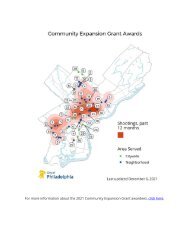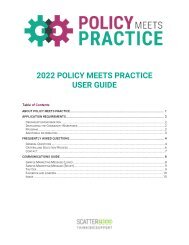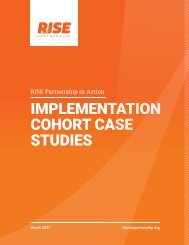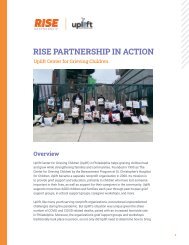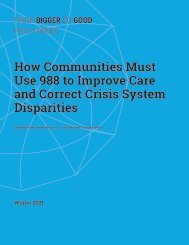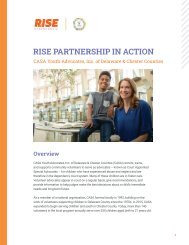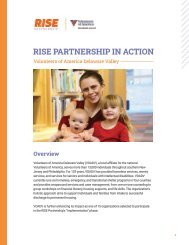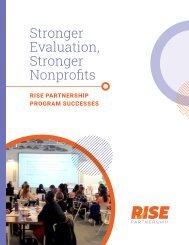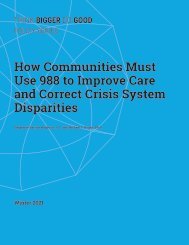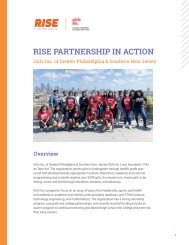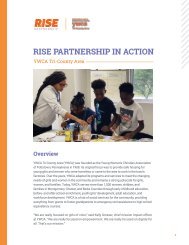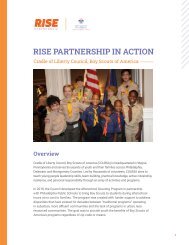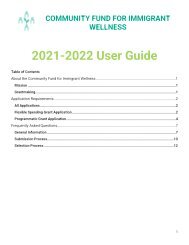Informed_Consent:A_Policy_Prescription_for_Communicating_Benefit_and_Risk_in_State_Medical_Marijuana_Programs
You also want an ePaper? Increase the reach of your titles
YUMPU automatically turns print PDFs into web optimized ePapers that Google loves.
THINK BIGGER DO GOOD<br />
POLICY SERIES<br />
<strong>In<strong>for</strong>med</strong> <strong>Consent</strong>:<br />
A <strong>Policy</strong> <strong>Prescription</strong><br />
<strong>for</strong> <strong>Communicat<strong>in</strong>g</strong><br />
<strong>Benefit</strong> <strong>and</strong> <strong>Risk</strong> <strong>in</strong><br />
<strong>State</strong> <strong>Medical</strong><br />
<strong>Marijuana</strong> <strong>Programs</strong><br />
Erik Messamore, M.D., Ph.D., <strong>and</strong> Sara E. Dugan, Pharm.D.<br />
Summer 2020<br />
<strong>In<strong>for</strong>med</strong> <strong>Consent</strong>: A <strong>Policy</strong> <strong>Prescription</strong> <strong>for</strong> <strong>Communicat<strong>in</strong>g</strong> <strong>Benefit</strong> <strong>and</strong> <strong>Risk</strong> <strong>in</strong> <strong>State</strong> <strong>Medical</strong> <strong>Marijuana</strong> <strong>Programs</strong> 1
Behavioral Health <strong>and</strong> the Individual Health Insurance Market
Dear Reader,<br />
Now is the time to solve the grow<strong>in</strong>g behavioral health needs <strong>in</strong> our country by advanc<strong>in</strong>g public<br />
policies that trans<strong>for</strong>m the delivery of mental health <strong>and</strong> substance use disorder services <strong>and</strong> address<br />
outdated fund<strong>in</strong>g mechanisms.<br />
This paper is part of Th<strong>in</strong>k Bigger Do Good, a series of papers launched <strong>in</strong> 2017 through the support <strong>and</strong><br />
leadership of the Thomas Scattergood Behavioral Health Foundation <strong>and</strong> Peg’s Foundation. While the<br />
paper topics cont<strong>in</strong>ue to evolve, our goal to develop a policy agenda to improve health outcomes <strong>for</strong> all<br />
rema<strong>in</strong>s constant.<br />
In partnership with national experts <strong>in</strong> behavioral health, <strong>in</strong>clud<strong>in</strong>g our editors, Howard Goldman<br />
<strong>and</strong> Constance Gartner, we identified seven critical topics <strong>for</strong> this third series of papers. Each paper<br />
identifies the problem <strong>and</strong> provides clear, actionable solutions.<br />
We hope you jo<strong>in</strong> us <strong>in</strong> advocat<strong>in</strong>g <strong>for</strong> stronger behavioral health policies by shar<strong>in</strong>g this paper with<br />
your programmatic partners, local, state, <strong>and</strong> federal decision makers, advocacy organizations, <strong>and</strong><br />
voters. To learn more about Th<strong>in</strong>k Bigger Do Good <strong>and</strong> to access the other papers <strong>in</strong> the series, visit<br />
www.th<strong>in</strong>kbiggerdogood.org<br />
S<strong>in</strong>cerely,<br />
Joseph Pyle, M.A.<br />
President<br />
Scattergood Foundation<br />
Found<strong>in</strong>g Partner of Series<br />
Rick Kellar, M.B.A.<br />
President<br />
Peg’s Foundation<br />
Found<strong>in</strong>g Partner of Series<br />
Jane Mogavero, Esq.<br />
Executive Director<br />
Patrick P. Lee Foundation<br />
Tracy A. Sawicki<br />
Executive Director<br />
Peter & Elizabeth Tower Foundation<br />
<strong>In<strong>for</strong>med</strong> <strong>Consent</strong>: A <strong>Policy</strong> <strong>Prescription</strong> <strong>for</strong> <strong>Communicat<strong>in</strong>g</strong> <strong>Benefit</strong> <strong>and</strong> <strong>Risk</strong> <strong>in</strong> <strong>State</strong> <strong>Medical</strong> <strong>Marijuana</strong> <strong>Programs</strong> 3
We would like to acknowledge the follow<strong>in</strong>g <strong>in</strong>dividuals <strong>for</strong> their participation <strong>in</strong><br />
the meet<strong>in</strong>g that led to the conceptualization of the paper series.<br />
Colleen L. Barry, Ph.D., M.P.P.<br />
John Hopk<strong>in</strong>s Bloomberg School of<br />
Public Health<br />
Cynthia Baum-Baicker, Ph.D.<br />
The Scattergood Foundation<br />
Anita Burgos, Ph.D.<br />
Bipartisan <strong>Policy</strong> Center<br />
Thom Craig, M.P.A.<br />
Peg’s Foundation<br />
Rebecca David, M.P.H.<br />
National Council <strong>for</strong> Behavioral Health<br />
Kelly Davis<br />
Mental Health America<br />
Lisa Dixon, M.D., M.P.H.<br />
Columbia University, NY <strong>State</strong> Psychiatric<br />
Institute, <strong>and</strong> Psychiatric Services<br />
Sara Dugan, Pharm.D., B.C.P.P., B.C.P.S.<br />
Northeast Ohio <strong>Medical</strong> University<br />
Peter Earley<br />
Author & Journalist<br />
Alyson Ferguson, M.P.H.<br />
The Scattergood Foundation<br />
Richard Frank<br />
Harvard <strong>Medical</strong> School<br />
Rachel Garfield, Ph.D., M.H.S.<br />
The Henry J. Kaiser Family Foundation<br />
Mary Giliberti, J.D.<br />
Mental Health America<br />
Aaron Glickman, B.A.<br />
Perelman School of Medic<strong>in</strong>e,<br />
University of Pennsylvania<br />
Sherry Glied, Ph.D.<br />
NYU Wagner School of Public Service<br />
Howard Goldman, M.D., Ph.D.<br />
University of Maryl<strong>and</strong> School<br />
of Medic<strong>in</strong>e<br />
Pamela Greenberg, M.P.P.<br />
Association <strong>for</strong> Behavioral Health<br />
<strong>and</strong> Wellness<br />
Kimberly Hoagwood, Ph.D.<br />
New York University School of Medic<strong>in</strong>e<br />
Michael F. Hogan, Ph.D.<br />
Hogan Health Solutions<br />
Chuck Ingoglia, M.S.W.<br />
National Council <strong>for</strong> Behavioral Health<br />
Rick Kellar, M.B.A.<br />
Peg’s Foundation<br />
Kelly Kelleher, M.D., M.P.H.<br />
The Research Institute at Nationwide<br />
Children’s Hospital<br />
Jennifer Mathis, J.D.<br />
Bazelon Center <strong>for</strong> Mental Health Law<br />
Donald Matteson, M.A.<br />
Peter & Elizabeth Tower Foundation<br />
Brian McGregor, Ph.D.<br />
Satcher Health Leadership Institute,<br />
Morehouse College<br />
Erik Messamore, M.D.<br />
Northeast Ohio <strong>Medical</strong> University<br />
Ben Miller, PsyD<br />
Well Be<strong>in</strong>g Trust<br />
Jane Mogavero, Esq.<br />
Patrick P. Lee Foundation<br />
Mark R. Munetz, M.D.<br />
Northeast Ohio <strong>Medical</strong> University<br />
S<strong>and</strong>ra Newman, Ph.D.<br />
John Hopk<strong>in</strong>s Bloomberg School of<br />
Public Health<br />
Joseph Pyle, M.A.<br />
The Scattergood Foundation<br />
Barbara Ricci<br />
Center <strong>for</strong> High Impact Philanthropy<br />
Cheryl Roberts, Esq.<br />
Greenberger Center<br />
Victoria Rom<strong>and</strong>a<br />
Peg’s Foundation<br />
Tracy A. Sawicki<br />
Peter & Elizabeth Tower Foundation<br />
Lloyd Sederer, M.D.<br />
NYS Office of Mental Health/Mailman<br />
School of Public Health<br />
Dom<strong>in</strong>ic Sisti, Ph.D.<br />
Scattergood Program <strong>for</strong> Applied Ethics<br />
<strong>in</strong> Behavioral Health Care & Perelman<br />
School of Medic<strong>in</strong>e at the University<br />
of Pennsylvania<br />
Andrew Sperl<strong>in</strong>g, J.D.<br />
NAMI<br />
Kate Williams, J.D.<br />
The Scattergood Foundation<br />
Glenda L. Wrenn, M.D., M.S.H.P.<br />
180 Health Partners<br />
<strong>In<strong>for</strong>med</strong> <strong>Consent</strong>: A <strong>Policy</strong> <strong>Prescription</strong> <strong>for</strong> <strong>Communicat<strong>in</strong>g</strong> <strong>Benefit</strong> <strong>and</strong> <strong>Risk</strong> <strong>in</strong> <strong>State</strong> <strong>Medical</strong> <strong>Marijuana</strong> <strong>Programs</strong> 4
Titles <strong>in</strong> the Paper Series<br />
Editors Howard Goldman, M.D., Ph.D. <strong>and</strong> Constance Gartner, M.S.W.<br />
America’s Opioid Epidemic<br />
Lloyd I. Sederer, M.D.<br />
Behavioral Health <strong>and</strong> the Individual Health Insurance Market: Preserv<strong>in</strong>g Key Elements of Re<strong>for</strong>m<br />
Richard G. Frank, Ph.D. <strong>and</strong> Sherry A. Glied, Ph.D., M.A.<br />
Br<strong>in</strong>g<strong>in</strong>g Treatment Parity to Jail Inmates with Schizophrenia<br />
Mark R. Munetz, M.D., Erik Messamore, M.D., Ph.D., <strong>and</strong> Sara E. Dugan, Pharm.D., B.C.P.P., B.C.P.S.<br />
Coord<strong>in</strong>ated Specialty Care <strong>for</strong> First-Episode Psychosis: An Example of F<strong>in</strong>anc<strong>in</strong>g <strong>for</strong> Specialty <strong>Programs</strong><br />
Lisa B. Dixon, M.D., M.P.H.<br />
Employ<strong>in</strong>g People with Mental Illness <strong>in</strong> the 21st Century: Labor Market Changes <strong>and</strong> <strong>Policy</strong> Challenges<br />
Richard G. Frank, Ph.D. <strong>and</strong> Sherry A. Glied, Ph.D., M.A.<br />
Fentanyl <strong>and</strong> the Evolv<strong>in</strong>g Opioid Epidemic: What Strategies Should <strong>Policy</strong>makers Consider?<br />
Colleen L. Barry, Ph.D., M.P.P.<br />
Improv<strong>in</strong>g Outcomes <strong>for</strong> People with Serious Mental Illness <strong>and</strong> Co-Occurr<strong>in</strong>g Substance Use<br />
Disorders <strong>in</strong> Contact with the Crim<strong>in</strong>al Justice System<br />
Glenda L. Wrenn, M.D., M.S.H.P., Brian McGregor, Ph.D., <strong>and</strong> Mark R. Munetz, M.D.<br />
Integrat<strong>in</strong>g Mental Health <strong>and</strong> Addiction Treatment <strong>in</strong> General <strong>Medical</strong> Care: The Role of <strong>Policy</strong><br />
Emma B. McG<strong>in</strong>ty, Ph.D., M.S., <strong>and</strong> Gail L. Daumit, M.D., M.H.S.<br />
Medicaid’s Institutions <strong>for</strong> Mental Diseases (IMD) Exclusion Rule: A <strong>Policy</strong> Debate<br />
Jennifer Mathis, J.D., Dom<strong>in</strong>ic A. Sisti, Ph.D. <strong>and</strong> Aaron Glickman, B.A.<br />
Meet<strong>in</strong>g the Needs of Justice-Involved People with Serious Mental Illness with<strong>in</strong> Community<br />
Behavioral Health Systems<br />
Natalie Bonf<strong>in</strong>e, Ph.D., Amy Blank Wilson, Ph.D., L.S.W., <strong>and</strong> Mark R. Munetz, M.D.<br />
Redesign<strong>in</strong>g Federal Health Insurance Policies to Promote Children’s Mental Health<br />
Kimberly Hoagwood, Ph.D., Kelly Kelleher, M.D., M.P.H, <strong>and</strong> Michael F. Hogan, Ph.D.<br />
<strong>Policy</strong> <strong>and</strong> Practice Innovations to Improve Prescrib<strong>in</strong>g of Psychoactive Medications <strong>for</strong> Children<br />
Kelly J. Kelleher, M.D., M.P.H., David Rub<strong>in</strong>, M.D., M.S.C.E., Kimberly Hoagwood, Ph.D.<br />
Suicide Is a Significant Health Problem<br />
Michael F. Hogan, Ph.D.<br />
The Current Medicaid <strong>Policy</strong> Debate <strong>and</strong> Implications <strong>for</strong> Behavioral Healthcare <strong>in</strong> the United <strong>State</strong>s<br />
Rachel Garfield, Ph.D., M.H.S. <strong>and</strong> Julia Zur, Ph.D.<br />
Youth Suicide Is Increas<strong>in</strong>g: Modest Actions Taken Now Can Save Lives<br />
Michael F. Hogan, Ph.D.<br />
F<strong>in</strong>d the papers onl<strong>in</strong>e at www.th<strong>in</strong>kbiggerdogood.org<br />
We are grateful <strong>for</strong> the partnership that allows this paper <strong>and</strong> others to appear<br />
<strong>in</strong> Psychiatric Services, a peer-reviewed monthly journal of the American Psychiatric<br />
Association. Content can be viewed at ps.psychiatryonl<strong>in</strong>e.org.<br />
<strong>In<strong>for</strong>med</strong> <strong>Consent</strong>: A <strong>Policy</strong> <strong>Prescription</strong> <strong>for</strong> <strong>Communicat<strong>in</strong>g</strong> <strong>Benefit</strong> <strong>and</strong> <strong>Risk</strong> <strong>in</strong> <strong>State</strong> <strong>Medical</strong> <strong>Marijuana</strong> <strong>Programs</strong> 5
<strong>In<strong>for</strong>med</strong> <strong>Consent</strong>:<br />
A <strong>Policy</strong> <strong>Prescription</strong><br />
<strong>for</strong> <strong>Communicat<strong>in</strong>g</strong><br />
<strong>Benefit</strong> <strong>and</strong> <strong>Risk</strong> <strong>in</strong><br />
<strong>State</strong> <strong>Medical</strong><br />
<strong>Marijuana</strong> <strong>Programs</strong><br />
Erik Messamore, M.D., Ph.D.<br />
Associate Professor of Psychiatry<br />
Department of Psychiatry<br />
Northeast Ohio <strong>Medical</strong> University<br />
emessamore@neomed.edu<br />
Sara E. Dugan, Pharm.D.<br />
Associate Professor of Psychiatry<br />
Department of Psychiatry<br />
Associate Professor of Pharmacy Practice<br />
Department of Pharmacy Practice<br />
Northeast Ohio <strong>Medical</strong> University<br />
sdugan@neomed.edu<br />
<strong>In<strong>for</strong>med</strong> <strong>Consent</strong>: A <strong>Policy</strong> <strong>Prescription</strong> <strong>for</strong> <strong>Communicat<strong>in</strong>g</strong> <strong>Benefit</strong> <strong>and</strong> <strong>Risk</strong> <strong>in</strong> <strong>State</strong> <strong>Medical</strong> <strong>Marijuana</strong> <strong>Programs</strong> 6
1<br />
Introduction<br />
<strong>Marijuana</strong> is an easily cultivated psychoactive plant that has been used<br />
ceremonially, recreationally, <strong>and</strong> medic<strong>in</strong>ally <strong>for</strong> thous<strong>and</strong>s of years. It has<br />
been essentially prohibited <strong>in</strong> the United <strong>State</strong>s s<strong>in</strong>ce 1937: first, by the Federal<br />
Marihuana Tax Act <strong>and</strong> then by placement <strong>in</strong> Schedule 1 of the federal Controlled<br />
Substances Act of 1970. Hobbled by federal restrictions, scientific research about<br />
marijuana has not kept pace with its popularity, which is surg<strong>in</strong>g. At a time<br />
when we most need high-quality data about marijuana’s health effects, we f<strong>in</strong>d a<br />
scientific knowledge base far below modern st<strong>and</strong>ards.<br />
At a time when we most need high-quality data<br />
about marijuana’s health effects, we f<strong>in</strong>d a scientific<br />
knowledge base far below modern st<strong>and</strong>ards.<br />
Respond<strong>in</strong>g to favorable public op<strong>in</strong>ion <strong>and</strong> well-f<strong>in</strong>anced political activity, many<br />
states have passed laws that permit the medical use of marijuana. However, <strong>in</strong><br />
creat<strong>in</strong>g medical marijuana laws, states face the challenge of mak<strong>in</strong>g sound policy<br />
about a substance with medical benefits that are currently unclear, with risks<br />
that are often contested, <strong>and</strong> <strong>in</strong> a sett<strong>in</strong>g where political pressures <strong>and</strong> f<strong>in</strong>ancial<br />
motives may <strong>in</strong>fluence decisions.<br />
This article offers suggestions <strong>for</strong> <strong>in</strong><strong>for</strong>m<strong>in</strong>g the public more effectively about the<br />
potential benefits <strong>and</strong> risks of marijuana <strong>in</strong> this challeng<strong>in</strong>g societal context.<br />
<strong>In<strong>for</strong>med</strong> <strong>Consent</strong>: A <strong>Policy</strong> <strong>Prescription</strong> <strong>for</strong> <strong>Communicat<strong>in</strong>g</strong> <strong>Benefit</strong> <strong>and</strong> <strong>Risk</strong> <strong>in</strong> <strong>State</strong> <strong>Medical</strong> <strong>Marijuana</strong> <strong>Programs</strong> 7
2<br />
Underst<strong>and</strong><strong>in</strong>g the<br />
Problem<br />
Term<strong>in</strong>ology<br />
Cannabis is the botanical name <strong>for</strong> a genus of flower<strong>in</strong>g plants. The genus<br />
conta<strong>in</strong>s three species (sativa, <strong>in</strong>dica, <strong>and</strong> ruderalis) <strong>and</strong> hundreds of selectively<br />
bred stra<strong>in</strong>s. The plants produce about 100 chemicals unique to the genus, <strong>and</strong><br />
these chemicals are collectively termed “cannab<strong>in</strong>oids.” The most important<br />
cannab<strong>in</strong>oids are tetrahydrocannab<strong>in</strong>ol (THC), which is <strong>in</strong>toxicat<strong>in</strong>g, <strong>and</strong><br />
cannabidiol (CBD), which is biologically active but not <strong>in</strong>toxicat<strong>in</strong>g. Hemp refers<br />
to cannabis stra<strong>in</strong>s with negligible THC content. <strong>Marijuana</strong> is a colloquial term<br />
that refers to cannabis plants, or their dried leaves or flowers, which conta<strong>in</strong> THC.<br />
Google Analytics suggests that more people speak of marijuana than cannabis,<br />
<strong>and</strong> the majority of state laws that have legalized cannabis have used the term<br />
“marijuana.” There<strong>for</strong>e, we use the term “marijuana” here to describe THCconta<strong>in</strong><strong>in</strong>g<br />
plants, leaves, or flowers from any Cannabis species.<br />
Google Analytics suggest that more people speak of<br />
marijuana than cannabis, <strong>and</strong> the majority of state<br />
laws that have legalized cannabis have used the<br />
term “marijuana.”<br />
Legal def<strong>in</strong>itions of marijuana <strong>in</strong> many states are considerably broader <strong>and</strong> may<br />
permit any cannab<strong>in</strong>oid at any concentration to be called “marijuana.” Highly<br />
concentrated products such as vap<strong>in</strong>g oils or solid concentrates (e.g., wax, budder,<br />
shatter) are often with<strong>in</strong> the legal def<strong>in</strong>ition of marijuana <strong>in</strong> most states. In many<br />
cases, legaliz<strong>in</strong>g marijuana is equivalent to legaliz<strong>in</strong>g pure THC.<br />
<strong>Marijuana</strong> policy re<strong>for</strong>m has created dist<strong>in</strong>ctions between recreational use <strong>and</strong><br />
medic<strong>in</strong>al use. Although issues related to the effects <strong>and</strong> potential harms apply to<br />
both medic<strong>in</strong>al <strong>and</strong> recreational use, there are important differences <strong>in</strong> the policy<br />
issues raised. <strong>Policy</strong> issues related to recreational use are outside the scope of<br />
this article.<br />
<strong>In<strong>for</strong>med</strong> <strong>Consent</strong>: A <strong>Policy</strong> <strong>Prescription</strong> <strong>for</strong> <strong>Communicat<strong>in</strong>g</strong> <strong>Benefit</strong> <strong>and</strong> <strong>Risk</strong> <strong>in</strong> <strong>State</strong> <strong>Medical</strong> <strong>Marijuana</strong> <strong>Programs</strong> 8
When a government declares someth<strong>in</strong>g to be a<br />
medic<strong>in</strong>e, there are responsibilities unique to medic<strong>in</strong>es<br />
that a government needs to consider. Declar<strong>in</strong>g someth<strong>in</strong>g<br />
to be a medic<strong>in</strong>e comes with duties to ensure that the<br />
claimed benefits are adequately supported by data <strong>and</strong><br />
that consumers are <strong>in</strong><strong>for</strong>med about credible hazards.<br />
This article exam<strong>in</strong>es the policy implications of state<br />
government medical marijuana approvals <strong>and</strong> offers<br />
suggestions to better <strong>in</strong><strong>for</strong>m the public about marijuana’s<br />
potential benefits <strong>and</strong> risks.<br />
<strong>Medical</strong> <strong>Marijuana</strong>: Popular, Profitable, <strong>and</strong> Political<br />
Despite federal prohibition, marijuana is widely used <strong>and</strong><br />
<strong>in</strong>creas<strong>in</strong>gly accepted across the United <strong>State</strong>s. Forty-five<br />
percent of U.S. adults have used marijuana, <strong>and</strong> between<br />
7% <strong>and</strong> 12% are current users (1, 2). In comparison, about<br />
14% of U.S. adults smoke tobacco cigarettes (3). The current<br />
number of marijuana users is the highest reported over the<br />
past decade (1). Support <strong>for</strong> legaliz<strong>in</strong>g marijuana has nearly<br />
quadrupled s<strong>in</strong>ce 1990, to the po<strong>in</strong>t that 61% of U.S. adults<br />
favor it (4).<br />
Public support <strong>for</strong> legalization is even stronger <strong>for</strong> medical<br />
uses of marijuana. More than 80% of Americans <strong>in</strong> a<br />
national survey reported that they believed that marijuana<br />
has at least one medic<strong>in</strong>al benefit, with pa<strong>in</strong> management<br />
<strong>and</strong> treatment of epilepsy <strong>and</strong> multiple sclerosis be<strong>in</strong>g<br />
the most commonly assumed benefits (5). Seventy-three<br />
percent of U.S. voters supported medical marijuana <strong>in</strong> a<br />
2010 Pew Research Center survey (6), <strong>and</strong> 86% of current<br />
marijuana supporters cite medical benefits as a reason<br />
why it should be legalized (7). Belief <strong>in</strong> the medical value<br />
of marijuana may be supported by the fact that each of<br />
marijuana’s two most important cannab<strong>in</strong>oids, THC <strong>and</strong><br />
CBD, have been approved <strong>for</strong> medical use by the U.S. Food<br />
<strong>and</strong> Drug Adm<strong>in</strong>istration (FDA).<br />
Legaliz<strong>in</strong>g marijuana also promises f<strong>in</strong>ancial benefits <strong>for</strong><br />
<strong>in</strong>vestors, bus<strong>in</strong>esses, <strong>and</strong> governments. About $30 billion is<br />
spent on marijuana every year <strong>in</strong> the United <strong>State</strong>s (8), <strong>and</strong><br />
many <strong>in</strong>dustry analysts predict double-digit annual growth<br />
(9). <strong>Marijuana</strong>-related bus<strong>in</strong>esses donate to both Republican<br />
<strong>and</strong> Democratic political campaigns <strong>in</strong> many states, <strong>and</strong><br />
marijuana-related federal lobby<strong>in</strong>g spend<strong>in</strong>g <strong>in</strong>creased by<br />
6,500% from 2014 to 2019 (10).<br />
<strong>State</strong>s Enter<strong>in</strong>g the Drug Approval Bus<strong>in</strong>ess under<br />
Suboptimal Conditions<br />
Respond<strong>in</strong>g to these <strong>in</strong>centives, 33 states <strong>and</strong> the District<br />
of Columbia have passed laws that legalize the cultivation,<br />
distribution, sale, or consumption of marijuana <strong>for</strong> medical<br />
use. These laws limit the medical use of marijuana to a set<br />
of diseases or symptoms deemed “qualify<strong>in</strong>g conditions.” (In<br />
Oklahoma’s program, however, any medical condition may<br />
be treated with marijuana if a doctor feels that it would be<br />
useful.) Each state decides <strong>for</strong> itself what level of medical<br />
evidence is needed to categorize an illness as treatable with<br />
marijuana. <strong>State</strong>s must also develop their own regulations <strong>for</strong><br />
the cultivation, distribution, promotion, <strong>and</strong> sale of marijuana<br />
<strong>and</strong> determ<strong>in</strong>e the extent to which potential risks should be<br />
disclosed to citizens. In effect, <strong>in</strong>dividual states have taken<br />
on roles usually h<strong>and</strong>led by larger, more experienced drugregulatory<br />
agencies, such as the FDA. Although states have<br />
always had the right to regulate commerce <strong>and</strong> the practices<br />
of medic<strong>in</strong>e <strong>and</strong> pharmacy with<strong>in</strong> their borders, drug approval<br />
<strong>and</strong> regulation are specialized tasks that require resources<br />
<strong>and</strong> experience often unavailable to state governments.<br />
<strong>In<strong>for</strong>med</strong> <strong>Consent</strong>: A <strong>Policy</strong> <strong>Prescription</strong> <strong>for</strong> <strong>Communicat<strong>in</strong>g</strong> <strong>Benefit</strong> <strong>and</strong> <strong>Risk</strong> <strong>in</strong> <strong>State</strong> <strong>Medical</strong> <strong>Marijuana</strong> <strong>Programs</strong> 9
Society has learned from earlier public health<br />
disasters that government approvals of proposed<br />
medical treatments should be based on rigorous<br />
cl<strong>in</strong>ical studies <strong>and</strong> that approvals should be<br />
restricted to a limited range of specifically<br />
def<strong>in</strong>ed doses.<br />
Society has learned from earlier public health disasters (11) that<br />
government approvals of proposed medical treatments should be based on<br />
rigorous cl<strong>in</strong>ical studies <strong>and</strong> that approvals should be restricted to a limited<br />
range of specifically def<strong>in</strong>ed doses. We have also learned that f<strong>in</strong>ancially or<br />
politically <strong>in</strong>vested parties should not be <strong>in</strong>volved <strong>in</strong> approval or regulatory<br />
decisions. Each of these basic pr<strong>in</strong>ciples of modern drug-approval ethics is<br />
radically compromised <strong>in</strong> state medical marijuana approval processes.<br />
The gold-st<strong>and</strong>ard test of medication effectiveness <strong>and</strong> safety is the<br />
r<strong>and</strong>omized, multisite, double-bl<strong>in</strong>d, placebo-controlled cl<strong>in</strong>ical trial. Drug<br />
regulators get the clearest possible picture of the true benefits <strong>and</strong> sideeffect<br />
risks of a proposed treatment by enroll<strong>in</strong>g a large number of wellcharacterized<br />
volunteers; r<strong>and</strong>omly assign<strong>in</strong>g them to active-treatment<br />
or placebo-treatment groups, under conditions where neither patient nor<br />
<strong>in</strong>vestigator is biased by know<strong>in</strong>g the group assignment; <strong>and</strong> regularly<br />
scor<strong>in</strong>g symptom severity <strong>and</strong> side-effect occurrence. However, largely<br />
because of marijuana’s illegal status under federal law, such cl<strong>in</strong>ical<br />
studies are extraord<strong>in</strong>arily difficult to conduct. Placebo-controlled studies<br />
on marijuana are also limited by the fact that marijuana is <strong>in</strong>toxicat<strong>in</strong>g.<br />
Buzzed volunteers easily know whether they have been assigned to activedrug<br />
or placebo groups, compromis<strong>in</strong>g study <strong>in</strong>tegrity. Federal marijuana<br />
policies <strong>and</strong> the lack of adequate placebo controls make gold-st<strong>and</strong>ard<br />
medical evidence <strong>for</strong> marijuana scarce. <strong>State</strong> regulators are often <strong>for</strong>ced to<br />
consider bodies of evidence that are more prone to ambiguous design or<br />
biased <strong>in</strong>terpretation.<br />
<strong>In<strong>for</strong>med</strong> <strong>Consent</strong>: A <strong>Policy</strong> <strong>Prescription</strong> <strong>for</strong> <strong>Communicat<strong>in</strong>g</strong> <strong>Benefit</strong> <strong>and</strong> <strong>Risk</strong> <strong>in</strong> <strong>State</strong> <strong>Medical</strong> <strong>Marijuana</strong> <strong>Programs</strong> 10
The dose of a drug is critically important <strong>in</strong> predict<strong>in</strong>g<br />
whether it will help or harm, yet the doses of active<br />
cannab<strong>in</strong>oids such as THC or CBD are rarely considered<br />
<strong>in</strong> state medical marijuana laws. In some cases, states<br />
may limit the amount of THC that can be purchased, but<br />
those limits can be high. Under Ohio’s medical marijuana<br />
law, a “whole-day unit” of edible marijuana may conta<strong>in</strong><br />
up to 110 mg of THC, <strong>and</strong> a whole-day unit of vap<strong>in</strong>g oil<br />
may conta<strong>in</strong> up to 590 mg of THC (12). Consumers may not<br />
purchase more than a 70-day supply of medical marijuana<br />
under Florida law. However, Florida has not yet def<strong>in</strong>ed<br />
how much THC constitutes a day’s supply. A rule-mak<strong>in</strong>g<br />
advisory panel has recommended sett<strong>in</strong>g the daily edible<br />
THC product limit at 1,000 mg (13). For reference, the<br />
maximum recommended daily THC dose <strong>for</strong> FDAapproved<br />
use is 20 mg (14).<br />
The potential benefits or risks of marijuana are also<br />
<strong>in</strong>fluenced by the ratio of the various cannab<strong>in</strong>oids with<strong>in</strong><br />
the marijuana product. A product with low THC <strong>and</strong> high<br />
CBD concentrations may have negligible <strong>in</strong>toxicat<strong>in</strong>g<br />
effects, but a variety with high THC <strong>and</strong> low CBD<br />
concentrations may be dangerously <strong>in</strong>toxicat<strong>in</strong>g. Most<br />
states do not address THC:CBD ratios <strong>in</strong> their def<strong>in</strong>itions of<br />
medical marijuana <strong>and</strong> many states permit <strong>for</strong>mulations<br />
that deliver THC at levels never found <strong>in</strong> nature.<br />
The route of adm<strong>in</strong>istration also <strong>in</strong>fluences the effects<br />
of marijuana. Inhalation of marijuana produces cl<strong>in</strong>ical<br />
effects with<strong>in</strong> a few m<strong>in</strong>utes but cannab<strong>in</strong>oids from edible<br />
marijuana products are absorbed over the course of hours<br />
<strong>and</strong> have longer-last<strong>in</strong>g effects. There is significantly<br />
greater risk <strong>for</strong> unpleasant psychiatric side effects from<br />
edible marijuana products (15). Many states make no<br />
regulatory dist<strong>in</strong>ction between <strong>in</strong>haled, topical, or edible<br />
marijuana products. This <strong>in</strong>attention to therapeutic dos<strong>in</strong>g<br />
is a major <strong>and</strong> potentially dangerous deviation from<br />
st<strong>and</strong>ard drug-regulatory practice.<br />
Many states make no regulatory<br />
dist<strong>in</strong>ction between <strong>in</strong>haled, topical,<br />
or edible marijuana products.<br />
Conflicts of Interest<br />
Conflicts of <strong>in</strong>terest can powerfully bias decision mak<strong>in</strong>g.<br />
Modern drug regulation is designed so that decisions<br />
about medication approval <strong>and</strong> regulation are made<br />
by <strong>in</strong>dividuals who will not directly benefit from these<br />
decisions. Many state politicians receive campaign<br />
contributions from marijuana bus<strong>in</strong>ess <strong>in</strong>terests, <strong>and</strong> state<br />
governments that legalize marijuana st<strong>and</strong> to generate tax<br />
revenue because of it. In cases <strong>in</strong> which state governments<br />
act as drug regulators, it is often unclear where the l<strong>in</strong>es<br />
are drawn between the people who make decisions related<br />
to legaliz<strong>in</strong>g marijuana <strong>and</strong> the politicians who<br />
appo<strong>in</strong>t them.<br />
<strong>In<strong>for</strong>med</strong> <strong>Consent</strong>: A <strong>Policy</strong> <strong>Prescription</strong> <strong>for</strong> <strong>Communicat<strong>in</strong>g</strong> <strong>Benefit</strong> <strong>and</strong> <strong>Risk</strong> <strong>in</strong> <strong>State</strong> <strong>Medical</strong> <strong>Marijuana</strong> <strong>Programs</strong> 11
Objective Assessments of <strong>Marijuana</strong>’s <strong>Benefit</strong>s <strong>and</strong> <strong>Risk</strong>s<br />
In light of these conflict-of-<strong>in</strong>terest concerns, it can be useful to rely on<br />
comprehensive analyses by neutral experts when assess<strong>in</strong>g the medical benefits<br />
or risks of marijuana. The National Academies of Sciences, Eng<strong>in</strong>eer<strong>in</strong>g, <strong>and</strong><br />
Medic<strong>in</strong>e was asked <strong>in</strong> 2016 to conduct a comprehensive review of the scientific<br />
literature regard<strong>in</strong>g the health effects of marijuana. The National Academies is a<br />
congressionally chartered organization tasked with provid<strong>in</strong>g objective analysis<br />
of complex problems, <strong>and</strong> the report is among the most comprehensive <strong>and</strong> most<br />
recent analyses of marijuana’s potential benefits <strong>and</strong> risks (16).<br />
In addition to describ<strong>in</strong>g benefits <strong>and</strong> risks, the report also considers the quality<br />
of scientific evidence support<strong>in</strong>g each f<strong>in</strong>d<strong>in</strong>g. Box 1 lists the health benefits <strong>and</strong><br />
risks supported by moderate evidence or better. “Moderate evidence” is def<strong>in</strong>ed as<br />
“several supportive f<strong>in</strong>d<strong>in</strong>gs from good- to fair-quality studies with very few or no<br />
credible oppos<strong>in</strong>g f<strong>in</strong>d<strong>in</strong>gs.”<br />
Surveys suggest that the U.S. public has an overly<br />
optimistic view of marijuana’s health effects.<br />
Public Misperceptions of <strong>Marijuana</strong>’s Health Effects<br />
Surveys suggest that the U.S. public has an overly optimistic view of marijuana’s<br />
health effects. Aside from legal problems or the possibility of addiction, the<br />
majority of adults believe that marijuana has no significant risks, <strong>and</strong> 9% of adults<br />
believe that it has no risks at all (5). Among youths between ages 16 <strong>and</strong> 19, survey<br />
data demonstrate that almost two-thirds of them (65.4%) are not worried at all<br />
that marijuana use will damage their health (17). Meanwhile, a third of adults<br />
believe that eat<strong>in</strong>g, smok<strong>in</strong>g, or vap<strong>in</strong>g marijuana products will actually prevent<br />
health problems (5).<br />
<strong>In<strong>for</strong>med</strong> <strong>Consent</strong>: A <strong>Policy</strong> <strong>Prescription</strong> <strong>for</strong> <strong>Communicat<strong>in</strong>g</strong> <strong>Benefit</strong> <strong>and</strong> <strong>Risk</strong> <strong>in</strong> <strong>State</strong> <strong>Medical</strong> <strong>Marijuana</strong> <strong>Programs</strong> 12
Inconsistent Messages about <strong>Marijuana</strong>’s<br />
<strong>Medical</strong> Uses <strong>and</strong> <strong>Risk</strong>s<br />
All states with medical marijuana laws describe their<br />
programs on state websites. These public <strong>in</strong><strong>for</strong>mation<br />
portals represent official communication from state<br />
governments to citizens. However, the <strong>in</strong><strong>for</strong>mation they<br />
provide sends the public <strong>in</strong>consistent <strong>and</strong> <strong>in</strong>accurate<br />
messages about the benefits or risks of marijuana. We<br />
surveyed each of these government websites to assess<br />
the number of medical conditions that qualified <strong>for</strong><br />
treatment with marijuana. We also searched each website<br />
to f<strong>in</strong>d whether, <strong>and</strong> to what extent, each state medical<br />
marijuana program described potential risks from<br />
marijuana treatment. The surveys were conducted <strong>in</strong><br />
2019, from July 15 to August 5, <strong>and</strong> <strong>in</strong>cluded each of the<br />
33 states with medical marijuana laws <strong>and</strong> the District<br />
of Columbia.<br />
Each website (except Oklahoma’s) lists the medical<br />
conditions eligible <strong>for</strong> treatment with marijuana. These<br />
medical approvals differ markedly across states. For<br />
<strong>in</strong>stance, the District of Columbia, Maryl<strong>and</strong>, <strong>and</strong> Florida<br />
recognize, respectively eight, n<strong>in</strong>e, <strong>and</strong> 11 qualify<strong>in</strong>g<br />
medical conditions, whereas Connecticut, North<br />
Dakota, <strong>and</strong> Ill<strong>in</strong>ois recognize 31, 32, <strong>and</strong> 40 conditions,<br />
respectively. The <strong>State</strong> of Oklahoma allows the use of<br />
marijuana to treat any medical condition that a physician<br />
feels would respond to marijuana treatment. For<br />
reference, the FDA has recognized two medical uses <strong>for</strong><br />
THC <strong>and</strong> two medical uses <strong>for</strong> CBD.<br />
Currently, no state medical marijuana program website<br />
<strong>in</strong><strong>for</strong>ms visitors of the quality of medical evidence used<br />
to determ<strong>in</strong>e the medical effectiveness of marijuana <strong>for</strong><br />
the listed qualify<strong>in</strong>g medical conditions. This suggests to<br />
consumers that all medical conditions are equally likely<br />
to benefit from marijuana or that its many listed implied<br />
benefits are equally well supported by medical evidence.<br />
Further, at least 24 of the nation’s 34 medical marijuana<br />
program websites omit <strong>in</strong><strong>for</strong>mation about potential side<br />
effects or long-term risks from us<strong>in</strong>g medical marijuana.<br />
Meanwhile, risk <strong>in</strong><strong>for</strong>mation can be challeng<strong>in</strong>g to locate<br />
with<strong>in</strong> the websites of state medical marijuana programs<br />
that do address risk. On the basis of the provided<br />
<strong>in</strong><strong>for</strong>mation, the average visitor to a medical marijuana<br />
program website may conclude that the risks are m<strong>in</strong>imal<br />
or that medical marijuana is risk free. For reference, the<br />
manufacturers of prescription THC or CBD list more than<br />
18 adverse reaction risks from each medication (14, 18).<br />
Although there are technical differences between a state’s<br />
designation of qualify<strong>in</strong>g medical condition <strong>and</strong> the FDA’s<br />
approval of a c<strong>and</strong>idate drug <strong>for</strong> medical treatment, the<br />
average consumer will see them as roughly equivalent.<br />
This <strong>in</strong>vites the public to overestimate the significance of<br />
state medical marijuana approvals.<br />
<strong>In<strong>for</strong>med</strong> <strong>Consent</strong>: A <strong>Policy</strong> <strong>Prescription</strong> <strong>for</strong> <strong>Communicat<strong>in</strong>g</strong> <strong>Benefit</strong> <strong>and</strong> <strong>Risk</strong> <strong>in</strong> <strong>State</strong> <strong>Medical</strong> <strong>Marijuana</strong> <strong>Programs</strong><br />
13
3<br />
Recommendations<br />
Fully Disclose Limits of Knowledge about <strong>Medical</strong> <strong>Benefit</strong>s<br />
Thanks to modern drug regulation, the public has come to expect that approved<br />
medications are safe <strong>and</strong> effective <strong>and</strong> that approvals are based on cl<strong>in</strong>ical studies<br />
that meet modern st<strong>and</strong>ards of quality. Consumers <strong>and</strong> the public deserve to know<br />
that these st<strong>and</strong>ards do not apply to medical marijuana. Each state’s medical<br />
marijuana program should disclose the quality of medical evidence underly<strong>in</strong>g each<br />
approved use of marijuana. It should expla<strong>in</strong> the rationale beh<strong>in</strong>d the approval of each<br />
qualify<strong>in</strong>g condition as well as the limitations or caveats related to each approval. This<br />
will allow <strong>in</strong>dividuals consider<strong>in</strong>g the use of medical marijuana <strong>and</strong> their health care<br />
providers to discuss the limits of the current medical evidence regard<strong>in</strong>g efficacy <strong>and</strong><br />
risks, <strong>in</strong>clud<strong>in</strong>g paradoxical reactions.<br />
Thanks to modern drug regulation, the public<br />
has come to expect that approved medications are<br />
safe <strong>and</strong> effective <strong>and</strong> that approvals are based on<br />
cl<strong>in</strong>ical studies that meet modern st<strong>and</strong>ards<br />
of quality.<br />
Fully Disclose <strong>and</strong> Publicize Potential <strong>Risk</strong>s<br />
In creat<strong>in</strong>g medical marijuana laws <strong>and</strong> specify<strong>in</strong>g qualify<strong>in</strong>g medical conditions,<br />
states declare to the public that marijuana has medical benefits. In l<strong>in</strong>e with modern<br />
drug regulation ethics, they should also specify its risks. <strong>State</strong>s should not offload<br />
the responsibility of risk education onto the shoulders of physicians or dispensary<br />
workers—these <strong>in</strong>dividuals did not confer the status of medic<strong>in</strong>e on marijuana.<br />
Further, most physicians have not been educated about marijuana risk <strong>and</strong> may<br />
actually be look<strong>in</strong>g to the experts <strong>in</strong> their state’s medical marijuana program <strong>for</strong><br />
risk guidance.<br />
<strong>In<strong>for</strong>med</strong> <strong>Consent</strong>: A <strong>Policy</strong> <strong>Prescription</strong> <strong>for</strong> <strong>Communicat<strong>in</strong>g</strong> <strong>Benefit</strong> <strong>and</strong> <strong>Risk</strong> <strong>in</strong> <strong>State</strong> <strong>Medical</strong> <strong>Marijuana</strong> <strong>Programs</strong> 14
We acknowledge that, like the evidence beh<strong>in</strong>d claims of<br />
marijuana’s medical benefits, the risk data may not be up<br />
to accepted st<strong>and</strong>ards. However, imperfect data should not<br />
be mis<strong>in</strong>terpreted as a safety signal; rather, such data call<br />
<strong>for</strong> even greater caution. Ethics dictate that the consumer<br />
has the right to know of scientifically credible concerns,<br />
<strong>and</strong> prudence dem<strong>and</strong>s that we err on the side of caution <strong>in</strong><br />
matters of health <strong>and</strong> safety.<br />
Independent <strong>and</strong> Transparent Assessment<br />
The processes <strong>for</strong> recogniz<strong>in</strong>g qualify<strong>in</strong>g medical conditions<br />
<strong>for</strong> medical marijuana use <strong>and</strong> the processes <strong>for</strong> identify<strong>in</strong>g<br />
potential risks should be st<strong>and</strong>ardized <strong>and</strong> clearly stated to<br />
the public.<br />
F<strong>in</strong>ancial or political conflicts of <strong>in</strong>terest should be<br />
elim<strong>in</strong>ated. Any committee that provides recommendations<br />
or makes decisions on legal uses of marijuana should<br />
be obligated to make a full disclosure of each member’s<br />
affiliations. Those with potential conflicts of <strong>in</strong>terest<br />
should be removed from the decision-mak<strong>in</strong>g process.<br />
Additionally, <strong>in</strong> cases where committee members are<br />
political appo<strong>in</strong>tees, the public should be <strong>in</strong><strong>for</strong>med as to<br />
whether the appo<strong>in</strong>t<strong>in</strong>g official has any affiliations with the<br />
marijuana <strong>in</strong>dustry or has received contributions from proor<br />
antimarijuana <strong>in</strong>terests.<br />
Implementation<br />
<strong>State</strong>s can use exist<strong>in</strong>g knowledge <strong>and</strong> <strong>in</strong>frastructure to<br />
more effectively communicate to the public the limits of<br />
medical knowledge about marijuana’s proposed medical<br />
benefits, as well as its potential risks, <strong>and</strong> to show how they<br />
address f<strong>in</strong>ancial or political conflicts of <strong>in</strong>terest <strong>in</strong> their<br />
medical marijuana policies.<br />
Independent comprehensive reviews of the evidence<br />
support<strong>in</strong>g medical uses of marijuana <strong>and</strong> of its potential<br />
risks already exist. The report from the National Academies<br />
of Sciences, Eng<strong>in</strong>eer<strong>in</strong>g, <strong>and</strong> Medic<strong>in</strong>e is the most recent<br />
example (16). Its f<strong>in</strong>d<strong>in</strong>gs could serve as a start<strong>in</strong>g po<strong>in</strong>t <strong>for</strong><br />
<strong>in</strong><strong>for</strong>m<strong>in</strong>g the public about benefits <strong>and</strong> risks.<br />
Dissem<strong>in</strong>ation <strong>in</strong>frastructure is also already <strong>in</strong> place.<br />
Every state with a medical marijuana program currently<br />
ma<strong>in</strong>ta<strong>in</strong>s its own website. Because these websites<br />
represent each state’s most authoritative sources of<br />
<strong>in</strong><strong>for</strong>mation about its program, they are likely to be visited<br />
by people consider<strong>in</strong>g the use of medical marijuana. The<br />
state medical marijuana program website is a logical place<br />
<strong>for</strong> the state to fulfill its ethical duty to provide <strong>in</strong><strong>for</strong>mation<br />
that a patient may require to make an <strong>in</strong><strong>for</strong>med decision<br />
about us<strong>in</strong>g marijuana <strong>for</strong> treatment.<br />
The work of identify<strong>in</strong>g potential medical benefits or<br />
risks <strong>and</strong> assess<strong>in</strong>g the quality of scientific evidence that<br />
supports each f<strong>in</strong>d<strong>in</strong>g is specialized <strong>and</strong> time consum<strong>in</strong>g.<br />
Such work dem<strong>and</strong>s cont<strong>in</strong>uous revision as new<br />
<strong>in</strong><strong>for</strong>mation becomes available. Given these considerations,<br />
such work may become burdensome <strong>and</strong> expensive <strong>for</strong><br />
<strong>in</strong>dividual states. We suggest that this work could be<br />
undertaken by a central agency whose work could be jo<strong>in</strong>tly<br />
funded by the states. Form<strong>in</strong>g such an agency would avoid<br />
duplicative processes <strong>in</strong> each state.<br />
<strong>In<strong>for</strong>med</strong> <strong>Consent</strong>: A <strong>Policy</strong> <strong>Prescription</strong> <strong>for</strong> <strong>Communicat<strong>in</strong>g</strong> <strong>Benefit</strong> <strong>and</strong> <strong>Risk</strong> <strong>in</strong> <strong>State</strong> <strong>Medical</strong> <strong>Marijuana</strong> <strong>Programs</strong> 15
To provide accurate <strong>in</strong><strong>for</strong>mation about the likelihood <strong>for</strong> benefit, state medical<br />
marijuana program websites should be designed so that visitors can easily see the<br />
quality of medical evidence support<strong>in</strong>g the use of marijuana to treat each of the<br />
qualify<strong>in</strong>g medical conditions that the state has identified. The websites should also<br />
rem<strong>in</strong>d visitors that not all diseases will respond equally well to marijuana, that some<br />
illnesses may be worsened by marijuana, <strong>and</strong> that the medical evidence support<strong>in</strong>g<br />
medical uses of marijuana is not up to modern st<strong>and</strong>ards of scientific quality.<br />
<strong>In<strong>for</strong>med</strong> decision mak<strong>in</strong>g about the medical<br />
use of marijuana also requires knowledge of its<br />
possible risks.<br />
<strong>In<strong>for</strong>med</strong> decision mak<strong>in</strong>g about the medical use of marijuana also requires<br />
knowledge of its possible risks. <strong>State</strong> medical marijuana websites can <strong>and</strong> should be<br />
modified to effectively <strong>in</strong><strong>for</strong>m visitors of marijuana’s scientifically credible risks. At a<br />
m<strong>in</strong>imum, an easy-to-f<strong>in</strong>d, easy-to-underst<strong>and</strong> list of the risks of marijuana use that<br />
are supported by at least moderate evidence must be made available to the public.<br />
Warn<strong>in</strong>g labels should be <strong>in</strong>cluded on marijuana product packag<strong>in</strong>g, <strong>and</strong> public<br />
service announcement campaigns highlight<strong>in</strong>g the known risks of marijuana use<br />
should be conducted. These measures have been effective <strong>in</strong> chang<strong>in</strong>g patterns<br />
of tobacco consumption <strong>and</strong> may reduce harm <strong>in</strong> vulnerable populations, such as<br />
pregnant women <strong>and</strong> adolescents (19).<br />
Similarly, the issue of transparency needs to be addressed. <strong>State</strong> medical marijuana<br />
program websites should also provide <strong>in</strong><strong>for</strong>mation that allows the public to<br />
underst<strong>and</strong> how decisions about marijuana uses <strong>and</strong> declarations are made, who<br />
makes the decisions, how they became decision makers, <strong>and</strong> whether they have<br />
f<strong>in</strong>ancial or partisan ties.<br />
<strong>In<strong>for</strong>med</strong> <strong>Consent</strong>: A <strong>Policy</strong> <strong>Prescription</strong> <strong>for</strong> <strong>Communicat<strong>in</strong>g</strong> <strong>Benefit</strong> <strong>and</strong> <strong>Risk</strong> <strong>in</strong> <strong>State</strong> <strong>Medical</strong> <strong>Marijuana</strong> <strong>Programs</strong> 16
4<br />
Conclusion<br />
There are good arguments <strong>for</strong> states to permit the medical use of marijuana.<br />
The ability of <strong>in</strong><strong>for</strong>med adults to act on their personal decisions is <strong>in</strong> l<strong>in</strong>e with<br />
the social value of freedom. Governments respond<strong>in</strong>g to the will of the majority<br />
is <strong>in</strong> l<strong>in</strong>e with the social value of democracy. Because some evidence suggests<br />
medical benefits from marijuana, mak<strong>in</strong>g it available to relieve suffer<strong>in</strong>g is <strong>in</strong> l<strong>in</strong>e<br />
with the value of compassion. There are also good arguments <strong>for</strong> chang<strong>in</strong>g federal<br />
regulations to make it easier to study marijuana to learn how to better exploit its<br />
possible benefits while m<strong>in</strong>imiz<strong>in</strong>g its risks.<br />
On the other h<strong>and</strong>, we need to be aware of the limits of our current knowledge,<br />
<strong>and</strong> states with medical marijuana laws or consider<strong>in</strong>g them should proceed with<br />
great caution. Some legalization advocates will object that our recommendations<br />
are unfounded or unfairly burdensome. We concede that expla<strong>in</strong><strong>in</strong>g marijuana’s<br />
risks <strong>and</strong> the uncerta<strong>in</strong>ties around its benefits will create more challeng<strong>in</strong>g policy<br />
mak<strong>in</strong>g, but this is better than endors<strong>in</strong>g poorly documented benefits <strong>and</strong> lett<strong>in</strong>g<br />
people learn about risk through firsth<strong>and</strong> experience.<br />
<strong>In<strong>for</strong>med</strong> <strong>Consent</strong>: A <strong>Policy</strong> <strong>Prescription</strong> <strong>for</strong> <strong>Communicat<strong>in</strong>g</strong> <strong>Benefit</strong> <strong>and</strong> <strong>Risk</strong> <strong>in</strong> <strong>State</strong> <strong>Medical</strong> <strong>Marijuana</strong> <strong>Programs</strong> 17
References<br />
1<br />
2<br />
3<br />
4<br />
5<br />
6<br />
7<br />
8<br />
9<br />
10<br />
11<br />
12<br />
13<br />
14<br />
15<br />
Key Substance Use <strong>and</strong> Mental Health Indicators <strong>in</strong> the United <strong>State</strong>s: Results From the 2016 National<br />
Survey on Drug Use <strong>and</strong> Health (HHS pub no SMA 17-5044, NSDUH Series H-52). Rockville, MD, Center <strong>for</strong><br />
Behavioral Health Statistics <strong>and</strong> Quality, Substance Abuse <strong>and</strong> Mental Health Services Adm<strong>in</strong>istration,<br />
2017. Available here https://www.samhsa.gov/data/sites/default/files/NSDUH-FFR1-2016/NSDUH-<br />
FFR1-2016.htm.<br />
Swift A: In US, 45% Say They Have Tried <strong>Marijuana</strong>. Wash<strong>in</strong>gton, DC, Gallup, 2017. Available here<br />
https://news.gallup.com/poll/214250/say-tried-marijuana.aspx.<br />
Current Cigarette Smok<strong>in</strong>g Among Adults <strong>in</strong> the United <strong>State</strong>s. Atlanta, Centers <strong>for</strong> Disease Control <strong>and</strong><br />
Prevention, 2019. Available here https://www.cdc.gov/tobacco/data_statistics/fact_sheets/adult_data/<br />
cig_smok<strong>in</strong>g/<strong>in</strong>dex.htm.<br />
Should <strong>Marijuana</strong> Be Made Legal? Chicago, NORC at the University of Chicago, General Social Survey Data<br />
Explorer, 2020. Available here https://gssdataexplorer.norc.org/trends/Civil%20Liberties?measure=grass.<br />
Keyhani S, Steigerwald S, Ishida J, et al: <strong>Risk</strong>s <strong>and</strong> benefits of marijuana use: a national survey of US adults.<br />
Ann Intern Med 169:282–290, 2018.<br />
Geiger AW, Gramlich J: 5 Facts About <strong>Marijuana</strong>. Wash<strong>in</strong>gton, DC, Pew Research Center, 2019. Available here<br />
https://www.pewresearch.org/fact-tank/2019/06/26/facts-about-marijuana/.<br />
Jones JM: In US, <strong>Medical</strong> Aid Top Reason Why Legal <strong>Marijuana</strong> Favored. Wash<strong>in</strong>gton, DC, Gallup, 2019.<br />
Available here https://news.gallup.com/poll/258149/medical-aid-top-reason-why-legal-marijuana-favored.<br />
aspx.<br />
Davenport SS, Caulk<strong>in</strong>s JP: Evolution of the United <strong>State</strong>s marijuana market <strong>in</strong> the decade of liberalization<br />
be<strong>for</strong>e full legalization. J Drug Issues 46:411–427, 2016.<br />
Williams S: How big could the marijuana <strong>in</strong>dustry grow? Alex<strong>and</strong>ria, VA, Motley Fool, 2019. Available here<br />
https://www.fool.com/<strong>in</strong>vest<strong>in</strong>g/2019/03/03/how-big-could-the-marijuana-<strong>in</strong>dustry-grow.aspx.<br />
Industry Profile: <strong>Marijuana</strong>. Wash<strong>in</strong>gton, DC, Center <strong>for</strong> Responsive Politics, 2019. Available here<br />
https://www.opensecrets.org/federal-lobby<strong>in</strong>g/<strong>in</strong>dustries/summary?id=N09.<br />
Merrill RA: Regulation of drugs <strong>and</strong> devices: an evolution. Health Aff 13:47–69, 1994.<br />
Quantity of <strong>Medical</strong> <strong>Marijuana</strong> That May Be Purchased by a Patient or Caregiver. Ohio Adm<strong>in</strong>istrative Code<br />
3796:8-2-04 (2017). Available here http://codes.ohio.gov/oac/3796:8-2-04.<br />
Kam D: Panel grapples with limits on marijuana doses. Ledger, Sept 18, 2018. Available here<br />
https://www.theledger.com/news/20180918/panel-grapples-with-limits-on-marijuana-doses.<br />
Mar<strong>in</strong>ol prescrib<strong>in</strong>g <strong>in</strong><strong>for</strong>mation. North Chicago, AbbVie, 2017. Available here<br />
https://www.accessdata.fda.gov/drugsatfda_docs/label/2017/018651s029lbl.pdf.<br />
Monte AA, Shelton SK, Mills E, et al: Acute illness associated with cannabis use, by route of exposure:<br />
an observational study. Ann Intern Med 170:531–537, 2019.<br />
<strong>In<strong>for</strong>med</strong> <strong>Consent</strong>: A <strong>Policy</strong> <strong>Prescription</strong> <strong>for</strong> <strong>Communicat<strong>in</strong>g</strong> <strong>Benefit</strong> <strong>and</strong> <strong>Risk</strong> <strong>in</strong> <strong>State</strong> <strong>Medical</strong> <strong>Marijuana</strong> <strong>Programs</strong> 18
16<br />
17<br />
18<br />
19<br />
The Health Effects of Cannabis <strong>and</strong> Cannab<strong>in</strong>oids: The Current <strong>State</strong> of Evidence <strong>and</strong> Recommendations<br />
<strong>for</strong> Research. Wash<strong>in</strong>gton, DC, National Academies of Sciences, Eng<strong>in</strong>eer<strong>in</strong>g, <strong>and</strong> Medic<strong>in</strong>e, National<br />
Academies Press, 2017. Available here https://www.nap.edu/catalog/24625/the-health-effects-of-cannabis<strong>and</strong>-cannab<strong>in</strong>oids-the-current-state.<br />
Wadsworth E, Hammond D: International differences <strong>in</strong> patterns of cannabis use among youth: prevalence,<br />
perceptions of harm, <strong>and</strong> driv<strong>in</strong>g under the <strong>in</strong>fluence <strong>in</strong> Canada, Engl<strong>and</strong> <strong>and</strong> United <strong>State</strong>s. Addict Behav<br />
90:171–175, 2019.<br />
Epidiolex prescrib<strong>in</strong>g <strong>in</strong><strong>for</strong>mation. Carlsbad, CA, Greenwich Biosciences, 2018. Available here<br />
https://www.accessdata.fda.gov/drugsatfda_docs/label/2018/210365lbl.pdf.<br />
WHO Report on the Global Tobacco Epidemic, 2008: The MPOWER Package. Geneva, World Health<br />
Organization, 2008. Available here https://www.who.<strong>in</strong>t/tobacco/mpower/gtcr_download/en/.<br />
Box 1. Health <strong>Benefit</strong>s <strong>and</strong> <strong>Risk</strong>s of <strong>Marijuana</strong> Use<br />
Symptoms <strong>for</strong> which benefits are supported<br />
by conclusive evidence<br />
<strong>Risk</strong>s with moderate evidence of association with<br />
marijuana use<br />
• Chronic pa<strong>in</strong> <strong>in</strong> adults<br />
• Nausea or vomit<strong>in</strong>g caused by chemotherapy<br />
• Patient-reported muscle spasms from multiple sclerosis<br />
Conditions <strong>and</strong> diseases <strong>for</strong> which benefits are<br />
supported by moderate evidence<br />
• Sleep disturbances <strong>in</strong> people with obstructive sleep<br />
apnea syndrome<br />
• Fibromyalgia, chronic pa<strong>in</strong><br />
• Multiple sclerosis<br />
<strong>Risk</strong>s with substantial evidence of association<br />
with marijuana use<br />
• Respiratory symptoms <strong>and</strong> bronchitis episodes,<br />
if smoked<br />
• Increased risk of motor vehicle crashes<br />
• Lower birth weight of babies whose mothers<br />
used marijuana dur<strong>in</strong>g pregnancy<br />
• The development of schizophrenia or other psychoses,<br />
with the highest risk among the most frequent users<br />
• Problematic marijuana use, such as addiction<br />
• Increased risk of potentially serious overdose <strong>in</strong>juries<br />
among children liv<strong>in</strong>g <strong>in</strong> marijuana-legal states<br />
• Impairments of learn<strong>in</strong>g, memory, or attention<br />
• Increased symptoms of mania or hypomania<br />
among people with bipolar disorders who regularly<br />
use marijuana<br />
• Small <strong>in</strong>creased risk of the development of<br />
depressive disorders<br />
• Increased <strong>in</strong>cidence of suicidal ideation <strong>and</strong> suicide<br />
attempts <strong>and</strong> suicide completion<br />
Integrat<strong>in</strong>g Mental Health <strong>and</strong> Addiction Treatment <strong>in</strong>to General <strong>Medical</strong> Care: The Role of <strong>Policy</strong><br />
• Increased <strong>in</strong>cidence of social anxiety disorder among<br />
regular marijuana users<br />
• Worsen<strong>in</strong>g of the negative symptoms of schizophrenia<br />
• Development of a substance use disorder <strong>for</strong> alcohol,<br />
tobacco, or illicit drugs<br />
19
How to use this paper to<br />
“Th<strong>in</strong>k Bigger” <strong>and</strong> “Do Good”<br />
1 Send the paper to your local, state, <strong>and</strong> federal<br />
policy- <strong>and</strong> decision-makers<br />
2 Share the paper with mental health <strong>and</strong> substance use<br />
advocates <strong>and</strong> providers<br />
The Scattergood Foundation believes major disruption is needed<br />
to build a stronger, more effective, compassionate, <strong>and</strong> <strong>in</strong>clusive<br />
health care system — one that improves well-be<strong>in</strong>g <strong>and</strong> quality of life<br />
as much as it treats illness <strong>and</strong> disease. At the Foundation, we THINK,<br />
DO, <strong>and</strong> SUPPORT <strong>in</strong> order to establish a new paradigm <strong>for</strong> behavioral<br />
health, which values the unique spark <strong>and</strong> basic dignity<br />
<strong>in</strong> every human.<br />
www.scattergoodfoundation.org<br />
3 Endorse the paper on social media outlets<br />
4 L<strong>in</strong>k to the paper on your organization’s website or blog<br />
5 Use the paper <strong>in</strong> group or classroom presentations<br />
6 Reference this article as published <strong>in</strong> Psychiatric<br />
Services <strong>and</strong> cite it as follows:<br />
Psychiatr Serv 2020; 71: doi.org/10.1176/appi.ps.202000140<br />
Peg’s Foundation believes <strong>in</strong> relevant <strong>and</strong> <strong>in</strong>novative, <strong>and</strong> at times<br />
disruptive ideas to improve access to care <strong>and</strong> treatment <strong>for</strong> the<br />
seriously mentally ill. We strive to promote the implementation of a<br />
stronger, more effective, compassionate, <strong>and</strong> <strong>in</strong>clusive health care<br />
system <strong>for</strong> all. Our Founder, Peg Morgan, guided us to “Th<strong>in</strong>k Bigger”,<br />
<strong>and</strong> to underst<strong>and</strong> recovery from mental illness is the expectation,<br />
<strong>and</strong> mental wellness is <strong>in</strong>tegral to a healthy life.<br />
www.pegsfoundation.org<br />
The Patrick P. Lee Foundation is a family foundation with two core<br />
fund<strong>in</strong>g areas - Education <strong>and</strong> Mental Health. The Foundation’s<br />
primary <strong>in</strong>vestments <strong>in</strong> education are through its scholarship<br />
programs <strong>in</strong> science, technology, eng<strong>in</strong>eer<strong>in</strong>g, <strong>and</strong> math. In mental<br />
health, the Foundation’s <strong>in</strong>vestments focus on strengthen<strong>in</strong>g the<br />
mental health work<strong>for</strong>ce, support<strong>in</strong>g community programs <strong>and</strong><br />
services, advocat<strong>in</strong>g <strong>for</strong> <strong>in</strong>creased public fund<strong>in</strong>g, <strong>and</strong> build<strong>in</strong>g the<br />
mental health literacy of the community.<br />
www.lee.foundation<br />
As strictly nonpartisan organizations, we do not grant permission <strong>for</strong> repr<strong>in</strong>ts, l<strong>in</strong>ks,<br />
citations, or other uses of our data, analysis, or papers <strong>in</strong> any way that implies the<br />
Scattergood Foundation, Peg’s Foundation, Peter & Elizabeth Tower Foundation, or<br />
Patrick P. Lee Foundation endorse a c<strong>and</strong>idate, party, product, or bus<strong>in</strong>ess.<br />
As grantmaker, partner, <strong>and</strong> advocate, the Tower Foundation<br />
strengthens organizations <strong>and</strong> works to change systems to improve<br />
the lives of young people with learn<strong>in</strong>g disabilities, mental illness,<br />
substance use disorders, <strong>and</strong> <strong>in</strong>tellectual disabilities.<br />
www.thetowerfoundation.org




